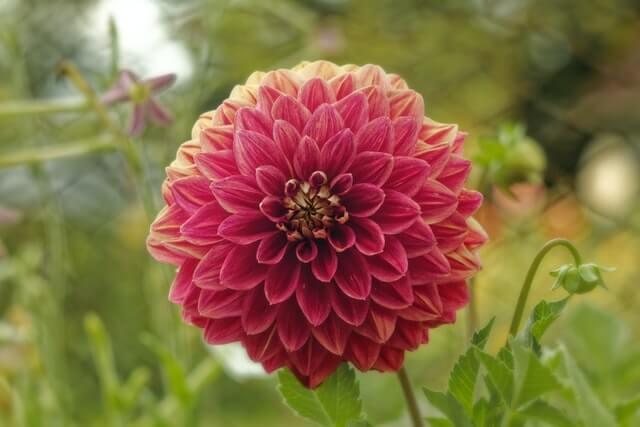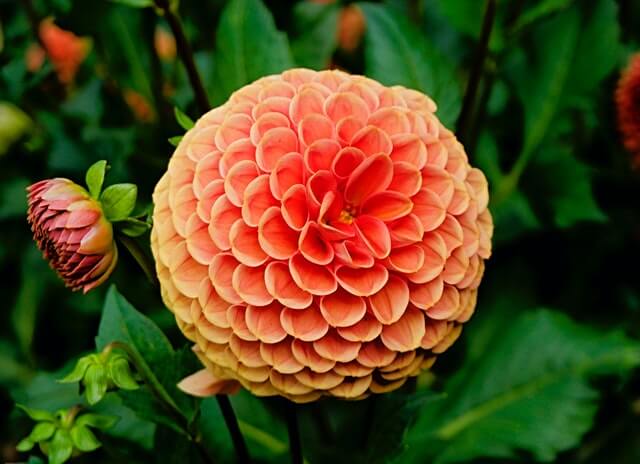If you have ever been to a beautiful flowering garden or nursery or to a state fair, you have probably noticed a pavilion filled with exotic and amazing dahlia blossoms. These hugely varietal flowers are the dream of every gardener from little starburst blooms to plate-sized flowers.
If the plant gets the right soil, appropriate light, and heat, it can be proven as a relatively sturdy plant.
Growing and caring guides of dahlia flowers may vary from place to place depending upon your zone, but here are a few dahlia growing and caring tips that can help you to get the greatest blooms and healthy, bushy plants.
So let’s dive into the blog and find out how to grow and care for dahlia plants.
Dahlia is a beautiful flowering plant belonging to the family of Asteraceae that also includes sunflower, zinnia, Aster, Daisy, Chrysanthemums, etc. Click To TweetPlant overview
Dahlia is a beautiful flowering plant belonging to the family of Asteraceae that also includes sunflower, zinnia, Aster, Daisy, Chrysanthemums, etc.
Dahlia thrives well in a moderate and moist climate. Thus they can’t be grown in hot climates like Texas, southern Florida, etc. However, they can brighten up a sunny garden anywhere during their growing season that at least lasts for 120 days.
In the colder regions of North America, these Dahlia flower plants are considered the perennial plants that are hardy in the hardiness zone of 8 to 11. However, gardeners in zone 6 to 7 can grow these beautiful plants in the ground and can be treated as the annual Plant.

So in colder regions, Dahlia flowers can be planted in the ground after the first frost and can be taken to the indoor house.
The Dahlia flowers can grow up to the size of 2inches like the lollipop-sized pom-poms to around 15-16 inches plate-sized pom poms. But most of the varieties grow up to 4 to 5 feet tall in size.
Although the Dahlia plant is a beautiful addition to your garden, it can be toxic to your dogs and cats. So be careful of planting it if you have a pet in your home.
Varieties of dahlia
You might be shocked after hearing that approximately there are 60,000 varieties of Dahlia flowers and 18 official flower forms including Stellar, peony, cactus, anemone, and waterlily, are there in this world. There are approximately 15 different color variants of Dahlia flowers that have been recognized by the American Dahlia society.
Some of the popular varieties of Dahlia are given below:
Bishop of Llandaff
This variety of Dahlia flowers grows small, intense, scarlet flowers with handsome, dark burgundy-colored foliage
Miss rose Fletcher
Miss Rose Fletcher is an elegant, spiky, pink cactus variety of Dahlia plants that beautifies the plant with 6 inches of circular, long, quilled, shell pink petals.
Bone asperence
Otherwise named as the Good hope bone asperence is a 1foot tall dwarf plant that bears 1 to 1.5 inches globes of rosy pink flowers during all the summer.
Kidd’s climax
Being the ultimate irrational beauty the Kidd’s climax bears large 10inces dinner plate flowers along with pink petals with golden diffusion.
Jersey’s beauty
Jersey’s beauty is the popular variety of the Dahlia flowers which is a 7-foot-tall pink plant along with palm-sized flowers that can add to your garden and energize it during the fall.

When to plant Dahlia?
As we have discussed earlier, Dahlia plants won’t grow in hot climates, so plant your dahlia plant after any danger of frost has passed.
Besides they can’t tolerate the soil temperature being cold. The ideal soil temperature for a Dahlia plant is 15° C or 60° F.
If you are a regular gardener, it is recommended to plant a dahlia plant after the seasons of tomato plantations in the ground. It is a good sign of the thumb rule.
Can Dahlia grow in a pot?
Yes, no doubt. They can be grown in a pot effectively. But it is recommended to grow medium to dwarf-sized Dahlia flower tubers in the pot.
To grow dahlia in a pot, select a pot of 12×12 inches in size with a good drainage system and bigger space to support the planting during maturity.
Fill the pot with soil, soilless mix, co polymer moisture-retaining crystal, etc. Follow the required depth and place the tuber in it and cover it up to a few inches with soil crystal mix.
Spray water on the tuber as much as required until the growth starts. Avoid watering if the soil is damp.
Fertilize the soil in the proper manner. Fertilizer is highly recommended during the summer.
If the soil gets exposed, add some extra soil to it.
Keep it in a place where it can get indirect and bright sunlight and let your plant grow.
How to plant Dahlia in the ground?
Dahlia flower plants can be planted into the ground. They generally grow from the tubers. So the first step before planting is to check a Dahlia tuber that is good for planting. Pink eyes or a little bit of green growth on the tuber is a good sign of a healthy tuber. The wrinkled and rotten tubers should be avoided.
It is recommended to plant a Dahlia plant in free space away from the competition so that they can grow freely. So space the Dahlia up to 3 feet from each other.
To plant the tuber of dahlia, dig the soil up to 6 to 8 inches deep. The hole must be slightly larger than the tuber of the dahlia. Add some compost or peat moss to the soil to increase the growth of the Dahlia. You can also add some bone meal during planting the tree. Otherwise, don’t fertilize it with other inorganic fertilizers during the planting.
Place the tuber in the ground with the eyes facing up. Make sure not to cut or break the tuber. Cover the tuber with soil up to 2 to 3 inches.
Don’t water the tuber soon after the planting. This can cause root rot. Wait until the sprouting of stems.
After the stems get sprouted, cover the whole hole with soil until it matches the ground level. Water your tubers properly.
How to care for dahlia plants?
Sunlight
Dahlia plant requires full sun to produce abundant blossoms. Dahlia plant grows well in 6 to 8 hours of direct sunlight, especially during the morning. It also requires mid-afternoon shade when the sun is too high.
Soil
Dahlias can thrive best in rich, well-draining soil with a pH level of 6.0 to 7.5. They prefer rich loamy soil with plenty of organic matter in it.
So it is recommended to amend the heavy clay soil with aged manure or compost to lighten and loosen the soil texture for better drainage of water.
Water
Water the dahlia plant 2 to 3 times a week once the plant is established. It is recommended to water your plant well in the summer during hot and dry climates.
Tend your plant before and after rain to fill up the open blooms with water and take a beating from the wind.
Fertilizer
Dahlia requires regular feeding. So it can get benefited from the occasional application of low nitrogen liquid fertilizer.
It is suggested to fertilize your plant soon after sprouting and every 3 to 4 weeks from the summer to autumn season.

Common pests and diseases
The Dahlia plant is very prone to be attacked by slugs and snails. To avoid this problem, start baiting your plant after plantation and continue it throughout the season.
The Dahlia plant is more likely to be attacked by the spider mites, earwigs, cucumber beetles, etc that can eat the petals of your flowers. To avoid this problem causing insects to start spraying anti insecticide sprays from late July to September.
Besides these insects, powdery mildews can cause problems for your plant during September. So take prevention and spray insecticide before the problem arises.
Conclusion
Reading this far article might have provided you with all the necessary data and guide for planting a dahlia flowers plant.
Growing a Dahlia flower plant in your garden is just like a button box. In addition to bringing beauty to your garden, it can also enhance the color pallet of your garden with its gorgeous, vibrant colored dahlia flowers.
So what are you waiting for?
Bring a dahlia plant to your home and enhance the beauty of your garden.
You may also like to read
How to grow and care for daylilies- A step-by-step guide
How to grow and care for Pineapple Lily plant – A step-by-step guide






